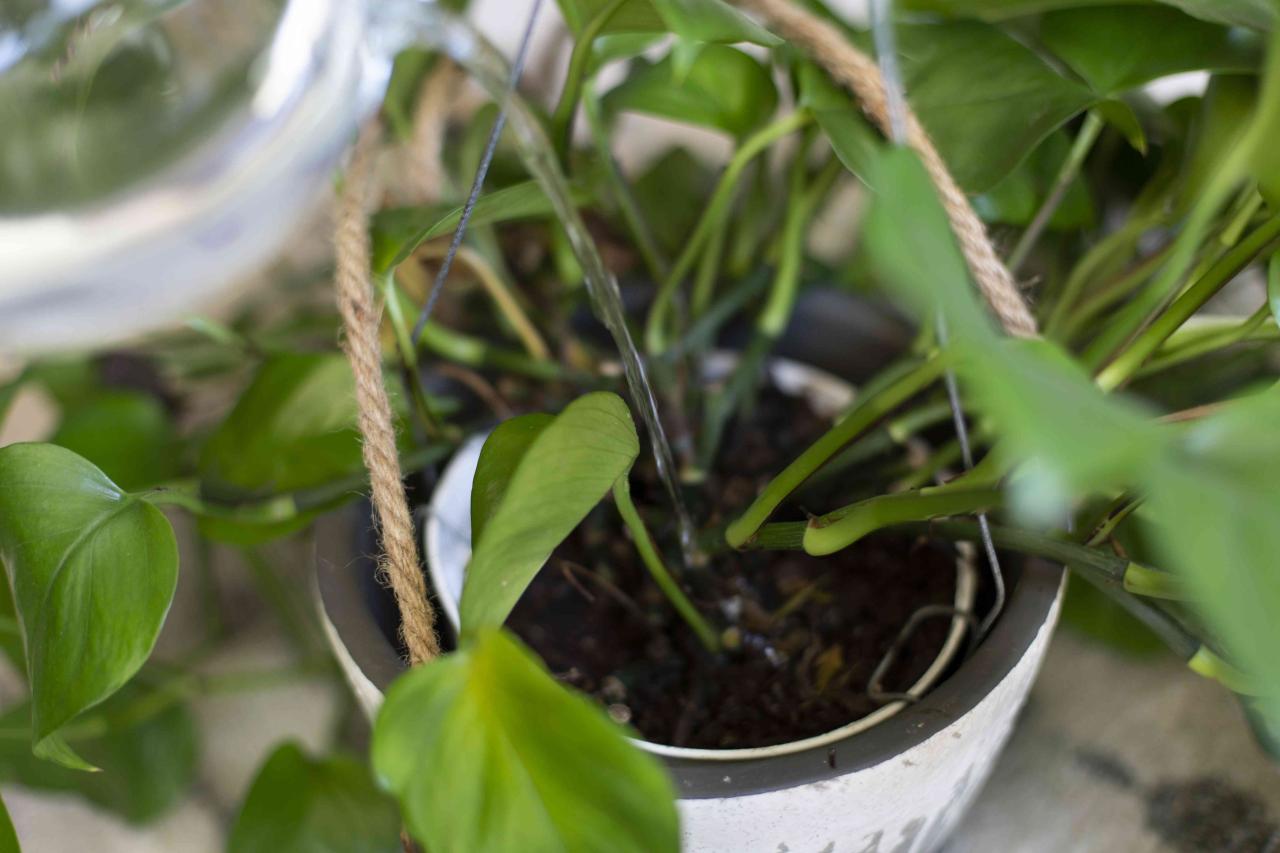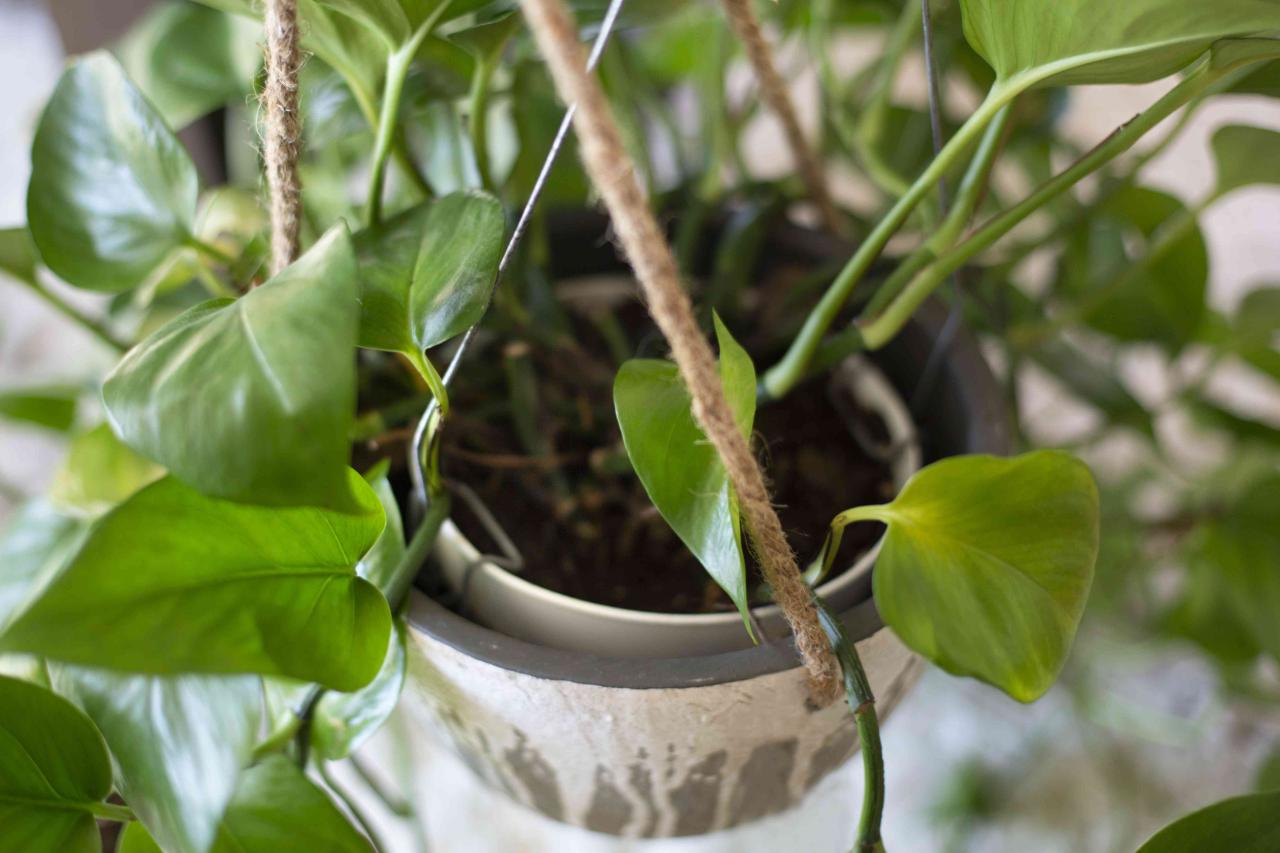How to Prevent Pests in Hanging Plants sets the stage for this enthralling narrative, offering readers a glimpse into a story that is rich in detail and brimming with originality from the outset.
Hanging plants, with their cascading beauty and vibrant foliage, are a delightful addition to any home or garden. However, these aerial beauties can also become susceptible to pesky insects that can quickly turn a lush display into a sorry sight.
Understanding the factors that attract pests and implementing preventive measures is crucial to maintaining healthy and thriving hanging plants. This comprehensive guide will equip you with the knowledge and strategies to keep your hanging plants pest-free and flourishing.
Choosing Pest-Resistant Plants

One of the most effective ways to prevent pests in your hanging plants is to select varieties known for their natural resistance. Many plants have evolved defenses that make them less appealing to common pests, reducing the risk of infestations.
Pest-Resistant Hanging Plant Species
Several hanging plant species are renowned for their resistance to common pests like aphids, spider mites, and mealybugs. These plants often possess characteristics that deter pests, such as:
- Strong, aromatic foliage:Plants like lavender, rosemary, and mint produce strong scents that repel insects.
- Tough, leathery leaves:Plants with thick, leathery leaves, such as succulents and some ferns, are less susceptible to chewing insects.
- Sticky, hairy surfaces:Plants with sticky or hairy surfaces, like some varieties of begonias, can trap small insects and make it difficult for them to move around.
- Naturally produced toxins:Some plants, like marigolds and chrysanthemums, produce natural toxins that deter insects.
Here are some examples of popular hanging plants known for their pest resistance:
- Succulents:String of pearls, burro’s tail, and echeveria are all succulent varieties that are generally pest-resistant. Their thick, fleshy leaves are less appealing to chewing insects.
- Herbs:Lavender, rosemary, mint, and thyme are not only beautiful but also repel common garden pests with their strong aromas.
- Vines:Boston ferns, pothos, and spider plants are known for their hardiness and resistance to pests.
- Flowers:Petunias, geraniums, and fuchsias are popular choices for hanging baskets and often show good pest resistance.
Comparing Pest Resistance
It’s important to note that even pest-resistant plants can be susceptible to infestations under certain conditions. Factors like stress, improper care, and environmental conditions can weaken plants and make them more vulnerable. For example, while succulents are generally resistant to insects, they can be prone to mealybugs if they are overwatered or kept in humid conditions.
Similarly, herbs like lavender may attract aphids if they are not properly watered or if the surrounding environment is infested.
While there are no guarantees, choosing pest-resistant plants is a proactive step towards preventing infestations. By selecting plants that are naturally less appealing to pests, you can significantly reduce the risk of encountering problems and enjoy healthier, more vibrant hanging gardens.
Just like hanging plants, Bonsai trees require careful attention to prevent pest infestations. Regularly inspecting your plants for signs of insects, such as aphids, mealybugs, or spider mites, is crucial. Early detection and treatment are key to keeping your hanging plants healthy and thriving.
Preventive Measures for Hanging Plants

While choosing pest-resistant plants is a crucial first step, proactive measures are essential to keep your hanging plants healthy and pest-free. Regular inspections, proper watering techniques, and the use of natural pest control methods are vital in preventing infestations and maintaining the vibrancy of your plants.
Preventive Measures for Common Hanging Plant Pests, How to Prevent Pests in Hanging Plants
Here’s a table outlining preventive measures for common hanging plant pests:
Pest Type |
Preventive Measure |
Description |
Image Description |
|---|---|---|---|
Aphids |
Neem oil spray |
A natural insecticide derived from the neem tree, effective in controlling aphids without harming beneficial insects. |
Illustrate a bottle of neem oil and a plant being sprayed with a fine mist, showcasing the application of the neem oil spray. |
Mealybugs |
Diatomaceous earth |
A fine powder made from fossilized diatoms that dehydrates and kills mealybugs by absorbing their moisture. |
Depict a close-up of diatomaceous earth dusted on a plant’s leaves and stems, emphasizing the fine powder and its application. |
Spider mites |
Regularly hosing down plants |
Strong water pressure dislodges spider mites and their webs, effectively removing them from the plant. |
Show a person gently hosing a hanging plant with a handheld sprayer, focusing on the water stream reaching the leaves and stems. |
Whiteflies |
Yellow sticky traps |
These traps attract and trap whiteflies, preventing them from laying eggs and multiplying. |
Display a yellow sticky trap with trapped whiteflies, showcasing the effectiveness of the trap in catching the pests. |
Regular Plant Inspection
Regularly inspecting your hanging plants is crucial for early pest detection. Look for signs of pests, such as:
- Tiny insects crawling on leaves or stems.
- Sticky residue on leaves, indicating honeydew from aphids or mealybugs.
- Fine webs on the undersides of leaves, a sign of spider mites.
- Small, white, flying insects, indicating whiteflies.
Early detection allows for swift intervention, preventing a full-blown infestation.
Benefits of Natural Pest Control Methods
Natural pest control methods offer numerous benefits over chemical pesticides, including:
- Environmental friendliness:Natural methods are less harmful to the environment, beneficial insects, and wildlife.
- Safety for humans and pets:They pose a lower risk to human health and pet safety.
- Sustainable approach:Natural methods promote a balanced ecosystem, reducing the need for continuous chemical interventions.
- Effectiveness:Many natural methods, when used correctly, can be highly effective in controlling pests.
By implementing preventive measures and embracing natural pest control methods, you can ensure the long-term health and beauty of your hanging plants, creating a thriving and pest-free oasis in your home.
Natural Pest Control Options
While preventive measures are crucial, sometimes pests may still find their way to your hanging plants. Fortunately, numerous natural pest control options can help combat these unwanted visitors without resorting to harsh chemicals.
Insecticidal Soap
Insecticidal soap is a widely used natural pesticide that effectively controls a variety of common pests, including aphids, mealybugs, whiteflies, and spider mites. This soap solution disrupts the protective outer layer of insects, causing them to dehydrate and die.
To prepare insecticidal soap, you can purchase a ready-made solution or make your own using:
- Ingredients:
- 1 tablespoon of liquid dish soap (non-detergent)
- 1 gallon of water
- Instructions:
- Mix the dish soap and water thoroughly.
- Pour the solution into a spray bottle.
- Spray the solution directly onto the infested plants, ensuring to coat the undersides of leaves where pests often hide.
- Repeat the application every few days until the infestation is controlled.
Garlic Spray
Garlic spray is a natural repellent that can effectively deter a range of pests, including aphids, spider mites, and whiteflies. The strong odor of garlic disrupts the insects’ sense of smell, making it difficult for them to locate plants.
To make a garlic spray, you will need:
- Ingredients:
- 4-5 cloves of garlic, crushed
- 1 quart of water
- Instructions:
- Combine the crushed garlic and water in a blender or food processor.
- Blend until the garlic is finely chopped.
- Strain the mixture through a cheesecloth or fine-mesh sieve to remove any solid particles.
- Pour the garlic solution into a spray bottle.
- Spray the solution onto the plants, focusing on the undersides of leaves and areas where pests are commonly found.
- Apply the garlic spray every few days to maintain its effectiveness.
Companion Planting
Companion planting involves strategically planting different plant species together to benefit from their natural interactions. Certain plants can repel pests or attract beneficial insects that prey on pests, thus creating a more balanced ecosystem in your hanging garden.
- Examples:
- Marigolds:Repel nematodes, whiteflies, and aphids.
- Basil:Repels mosquitoes, flies, and tomato hornworms.
- Mint:Repels ants, aphids, and cabbage moths.
End of Discussion

By understanding pest attractants, choosing resistant plants, and employing preventive measures, you can create a healthy environment for your hanging plants and deter unwanted pests. Regular inspection, natural pest control methods, and proper plant care are key to maintaining a thriving display of vibrant greenery.
Remember, a little vigilance goes a long way in keeping your hanging plants healthy and pest-free.
Key Questions Answered: How To Prevent Pests In Hanging Plants
What are the most common pests that affect hanging plants?
Common pests that affect hanging plants include aphids, mealybugs, spider mites, and whiteflies.
Can I use pesticides to control pests on my hanging plants?
While pesticides can be effective, they can also harm beneficial insects and pollute the environment. Natural pest control methods are generally safer and more sustainable.
How often should I inspect my hanging plants for pests?
Regularly inspect your hanging plants, at least once a week, for signs of pests. Early detection is crucial for effective control.

